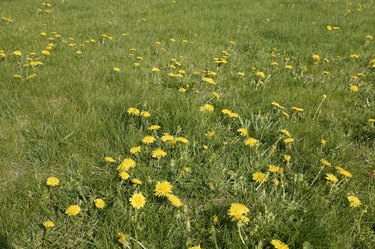
Weed and feed is a product sold under many different names, but in essence is a combination of herbicides to kill weeds and pesticides to simultaneously boost lawn health. The time it takes to kill weeds varies considerably, depending on factors such as weed type, fertilizer type and proper application.
Post-Emergent Formulas
Video of the Day
Post-emergent formulas kill weeds that are already growing. Usually, it takes between five and seven days for you to notice results and up to 21 days for weeds to disappear completely. Always apply weed and feed at proper times, as post-emergent herbicides will have no effect unless weeds are actively growing. This also means you should wait a few days after mowing, since cutting them down puts them in a temporarily dormant state. Usually you want to apply post-emergent weed and feed in fall, when weeds are actively growing but have not yet gone to seed. Waiting until after weeds have seeded will prolong the problem.
Video of the Day
Pre-Emergent Formulas
Pre-emergent weed and feed formulas stop weeds from appearing in the first place, so the kill happens during the very early stages. This can be effective against weeds such as crabgrasses (Digitaria spp.) and many types of broadleaf weeds. Crabgrass is hardy in U.S. Department of Agriculture plant hardiness zones 4 through 9. The time to death can vary for pre-emergent herbicides, but occurs between the time when the weed seed germinates and when the resulting sprout emerges through the soil. Because most pre-emergent herbicides remain active for between six and eight weeks, you should apply in spring before weeds appear. Any weeds that sprout during the period of effectiveness will likely die.
Weed Population Death
Although killing individual plants with weed and feed contributes to the weed population death, your lawn will not be entirely weed free until all existing weed plants and all seeds in the soil are entirely eliminated. Even gardeners who carefully apply weed and feed at the right times every year may have to wait several years for weeds to stop appearing completely. Once you stop seeing new weeds, your weed population has likely been eradicated, and you can move to traditional lawn fertilizers with occasional spot treatments of weeds.
Effectiveness Factors
If your weeds don't disappear entirely when you apply post-emergent weed and feed, the problem could be user error. Don't apply during unseasonably hot weather, as this limits effectiveness. Wait two to four days after mowing the lawn to ensure weeds are actively growing, and do not mow for several days afterwards. Apply when no heavy rains are expected, and don't water for two to four days. Your lawn should be damp, however, so apply one day after rain or irrigation. Often, post-emergent weed and feed is more effective in fall, when weeds are trying to store energy in their roots, than in spring, when they have lots of it available.
- Menards: What to Know About Weed and Feed Fertilizer
- Cornell University College of Agricultural and Life Sciences: Lawn Myth Busting: Skip Spring ‘Weed and Feed’
- One Project Closer: When and How to Apply Weed & Feed
- Eartheasy: 6 Reasons to Avoid Weed & Feed on Your Lawn
- Scotts Lawn Service: Frequently Asked Questions
- Bayer Advanced: Understanding Weed Killers
- Nancy Peters the Weed Lady: Crabgrass, Digitaria